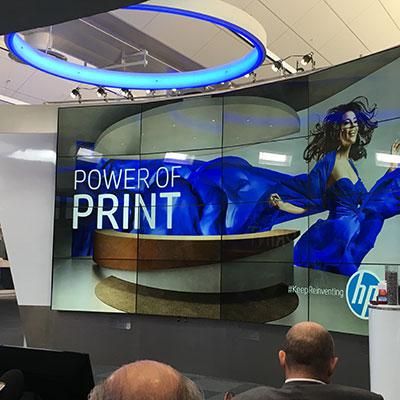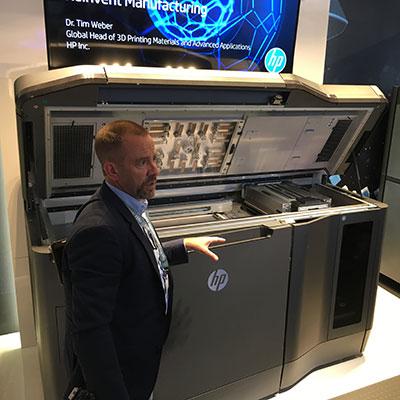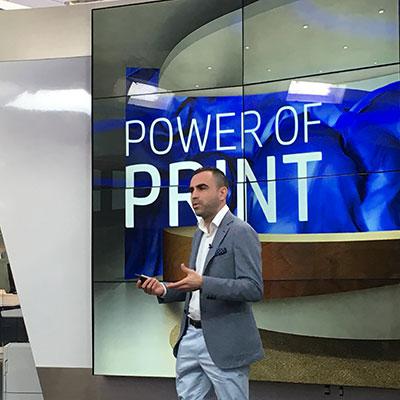5 Signs HP's Printer Business Is Firing On All Cylinders

The Future Of Printing
The printer market is not dead -- it's just been lacking in imagination and execution. That, at least, is the message coming from HP Inc. The company held an event for journalists and analysts last week at its Palo Alto, Calif., headquarters to make its case for why print is a cutting-edge technology area once again. HP's recent moves -- and growth -- in printer hardware and services suggest things are on track so far, as the company seeks to cement its own identity following the split from the HP Enterprise wing in late 2015.
What follows are five key areas in the printer market on view at last week's "Power of Print" event, where HP is moving fast.

HP Is Eyeing Expanded Uses For Its Sprocket Printer
One of HP's most experimental bets in the printer market since splitting off from the enterprise wing is the Sprocket, a pocket-size consumer printer. Introduced this past September, Sprocket prints out 2 x 3-inch photos that double as stickers, and the printing is done wirelessly from a user's smartphone. The aim, HP has said, is to inspire people who usually don't do much printing (i.e., millennials). The experiment seems to be working: HP said the product sold out over the holiday season and has been seeing strong sales since then, leading to the expansion of geographic markets (and addition of a red color edition) for Sprocket last week. "We're now in country expansion mode," said Anneliese Olson, general manager and global head for home printing solutions at HP, during the Power of Print event.
Olson said the company will also consider other uses for the Sprocket concept outside the consumer space. One key vertical could be education, with possible uses for school projects and printing out students' pictures on the first day of school, she said.

The Big Push To Capture A3 Market Share Appears On Track
HP's big new bet in business printing, meanwhile, is around A3 multifunction printer/copiers -- a market where HP hasn't historically been a major player. Last fall, HP unveiled a slew of new A3 models as well as a deal to acquire Samsung's printer business, which includes A3s. HP's new A3 models -- which apply HP's know-how from the A4 printer market to copiers -- are now starting to ship, including laser and PageWide models. This comes as HP reported that its printer business revenue grew 2 percent during its fiscal 2017 second quarter, ended April 30, after two quarters of declining revenue for print. The growth and product positioning "gives us a tremendous amount of confidence that we can actually go after the A3 $55 billion [market]," said Tuan Tran (pictured), general manager and global head for HP's Office Printing Solutions division, during the Power of Print event. Meanwhile, the Samsung acquisition is "on track" to close during the second half of the year, Tran said. Together with the team that's moving over from Samsung, "I think we can really go and change the office printing market," he said.

HP Aims To Revolutionize Manufacturing With 3-D Printing -- But Not Overnight
In May, HP formally launched a channel program for its Jet Fusion 3-D printer with 13 highly specialized North America partners. The product aims to stand apart from other 3-D printers on the market by focusing on manufacturing production-ready parts, rather than meeting the needs of product prototyping or consumers. The Jet Fusion 3-D printer has the ability to make parts at up to 10X the speed and half the cost, said Tim Weber (pictured), global head of 3-D printing materials and advanced applications at HP, during the Power of Print event.
The printer has the potential to "transform the whole manufacturing industry," said Enrique Lores, president of the Imaging, Printing and Solutions Business at HP, during the event. That's a far bigger market than the consumer and prototyping 3-D printer market, but "the adoption is also slower. We're talking about transforming manufacturing practices -- changing how planes are produced," for instance, he said. "We don't think this is something that will be material for us in the next two to three years. But it's the best growth opportunity for the company in the next five to 10 years. We're investing today to make that possible."

HP Is As Bullish As Ever On Managed Print Services
The print strategy at HP is about more than just new hardware and advanced security capabilities -- in many ways, the print business is becoming a services play. HP is shifting its print business "from transactional to contractual," said Tran during the Power of Print event. In print services, in fact, partner-led managed print services is HP's fastest-growing segment, company executives said. HP managed print services are now growing twice as fast as the overall MPS market, the company said. And it's not expected to slow any time soon. "We expect its growth to accelerate because of the launch of A3. Because as we grow into the A3 space, there will be many printers sold in MPS," said Lores (pictured). "We're investing more than we were in the past."

Printer Security Is A Dangerous Blind Spot For Many Companies
Take it from former hacker Michael Calce (pictured): Printers represent a massive vulnerability in many organizations' networks, and the issue is getting far too little attention. That was the message from Calce who, as a teenager, took down websites including Amazon and Yahoo in 2000 with a massive denial-of-service attack. Calce, who changed directions and now provides penetration testing services, spoke during the Power of Print event about the lack of awareness in the corporate world about the printer security threat. "Are CISOs even aware this is a potential threat? There are so many [printer] endpoints on the network, and they're unmonitored," Calce said. "No one's paying attention to this. Hackers know this – it's like low-hanging fruit."
Both software and hardware solutions should be considered for enhancing printer security, he said. And moving forward, printers are only expected to get more functionality, which will add more entry points for hackers, Calce said. "It's crucial to really instill several layers of security," he said. "Right now it's kind of an open door."